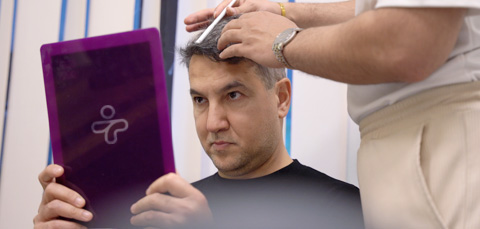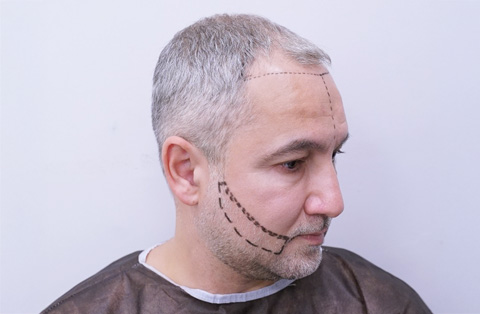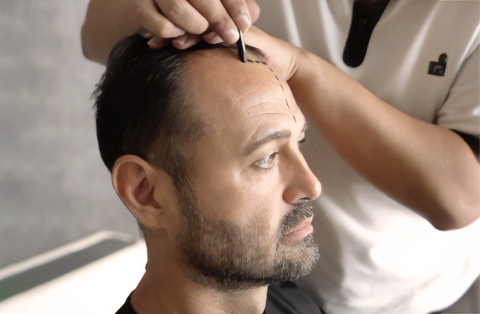Sapphire FUE (Follicular Unit Extraction) represents a significant leap forward in the field of hair transplantation, setting a new standard for precision and patient outcomes. This advanced method has quickly gained recognition as a leading choice for those seeking effective solutions for hair loss.
Overview of Sapphire FUE as an Advanced Hair Transplant Method:
Sapphire FUE is an innovative approach to hair transplantation that utilizes blades made from sapphire, a precious gemstone known for its exceptional hardness and sharpness. This technique refines the traditional FUE process, where individual hair follicles are extracted from the donor area and then implanted into the recipient site.
The use of sapphire blades allows for more precise incisions, minimizing trauma to the scalp and enhancing the overall effectiveness of the procedure. This precision not only improves the healing process but also ensures that the transplanted hair looks natural and blends seamlessly with the existing hair.
The Evolution of Hair Transplant Techniques Leading to Sapphire FUE:
The journey to the development of Sapphire FUE has been marked by continuous advancements in hair restoration technology. Initially, hair transplants involved the use of larger grafts, which often led to unnatural-looking results.
The introduction of FUE was a game-changer, offering more natural outcomes by transplanting individual follicular units. However, the quest for even better results and reduced trauma led to the innovation of Sapphire FUE. By replacing the traditional steel blades with sapphire ones, surgeons could create finer, more precise incisions, leading to less scarring and quicker recovery times.
This evolution reflects the ongoing commitment to providing patients with the most advanced and effective hair restoration solutions available.
In summary, Sapphire FUE stands at the forefront of hair transplant technology, offering a sophisticated solution that combines the latest advancements in medical science with the natural beauty and durability of sapphire. Its development marks a significant milestone in the evolution of hair restoration techniques, providing patients with a highly effective, minimally invasive option for combating hair loss.
What is Sapphire FUE Hair Transplant?
Sapphire FUE (Follicular Unit Extraction) hair transplant is a state-of-the-art method in the field of hair restoration techniques, distinguished by its use of sapphire blades, which sets it apart from traditional FUE and other hair transplant techniques.
Detailed Explanation of the Sapphire FUE Process:
- Extraction Phase: Similar to traditional FUE, the Sapphire FUE process begins with the extraction of individual hair follicles from the donor area, usually at the back of the scalp. This is done using a microsurgical extraction tool.
- Use of Sapphire Blades: The defining feature of Sapphire FUE is the use of blades made from sapphire for making incisions in the recipient area. Sapphire, known for its hardness and sharpness, allows for more precise and finer incisions compared to the steel blades used in traditional FUE.
- Implantation: The extracted follicles are then implanted into the incisions made by the sapphire blades. The precision of these incisions helps in placing the grafts at the correct angle and depth, which is crucial for achieving a natural appearance and high-density hair growth.
How Sapphire FUE Differs from Traditional FUE and Other Hair Transplant Methods?
- Reduced Trauma and Faster Healing: The finer incisions made by sapphire blades cause less trauma to the scalp compared to traditional steel blades. This results in reduced bleeding and faster healing of the recipient area.
- Minimized Scarring: The precision of sapphire blades also leads to minimized scarring, making it an excellent option for patients concerned about visible signs of hair transplantation.
- Enhanced Natural Appearance: The accuracy in creating incisions allows for a more natural distribution of hair, ensuring that the transplanted hair blends seamlessly with the existing hair.
- Suitability for Dense Packing: Sapphire FUE is particularly effective for dense packing, where a high number of grafts are transplanted, due to the precision of the sapphire blades.
In summary, Sapphire FUE is an advanced hair transplant technique that enhances the traditional FUE process by utilizing sapphire blades. This innovation leads to less trauma, quicker healing, minimal scarring, and more natural-looking results, making it a preferred choice for many seeking hair restoration solutions.
Benefits of Sapphire FUE Hair Transplant
The Sapphire FUE (Follicular Unit Extraction) hair transplant method offers a range of significant benefits, primarily stemming from the use of sapphire blades, which enhance the precision and efficiency of the procedure. These advantages contribute to its growing popularity in the field of hair restoration.
Enhanced Precision and Reduced Trauma Using Sapphire Blades:
- Finer Incisions: Sapphire blades are known for their sharpness and durability, allowing for finer and more precise incisions compared to traditional steel blades. This precision reduces trauma to the scalp during the incision phase.
- Less Tissue Damage: The reduced size and sharpness of the sapphire blades mean less damage to the surrounding tissue. This minimizes bleeding and discomfort during the procedure.
Improved Healing and Natural-Looking Results:
- Faster Recovery: Due to the minimally invasive nature of the incisions made with sapphire blades, patients typically experience a faster healing process. The reduced trauma to the scalp facilitates quicker recovery times.
- Natural Hair Growth: The precision of sapphire blades allows for accurate placement of hair follicles, which is crucial for achieving a natural-looking hairline and hair density. The transplanted hair blends seamlessly with the existing hair, enhancing the overall aesthetic appeal.
High Success Rates and Patient Satisfaction:
- Effective Hair Transplantation: The advanced technique used in Sapphire FUE, combined with the skill of the surgeon, often leads to high success rates in hair transplantation. Patients generally see significant improvements in hair density and coverage.
- High Patient Satisfaction: The combination of a less invasive procedure, quicker recovery, and natural-looking results contribute to high levels of patient satisfaction. Many patients report a positive impact on their self-esteem and overall quality of life post-transplant.
- Long-Term Results: The results of a Sapphire FUE hair transplant are typically long-lasting. The transplanted hair follicles, once established, continue to grow naturally for years.
In summary, Sapphire FUE hair transplant offers enhanced precision, reduced trauma, improved healing, and natural-looking results, leading to high success rates and patient satisfaction. These benefits make it an attractive option for individuals seeking an advanced solution to hair loss, with a focus on aesthetic quality and patient comfort.
The Sapphire FUE Procedure Step-by-Step
The Sapphire FUE (Follicular Unit Extraction) procedure is a detailed and meticulous process that involves several key steps, from initial preparations to post-procedure care.
Understanding this process can help patients know what to expect and how to prepare for the best possible outcomes.
Pre-Procedure Preparations and Patient Evaluation:
- Initial Consultation: The journey begins with a thorough consultation, where the hair transplant specialist evaluates the patient’s hair loss pattern, discusses expectations, and assesses the suitability for the Sapphire FUE procedure.
- Planning the Procedure: The surgeon carefully plans the procedure, determining the number of grafts needed and designing the hairline. This step is crucial for achieving a natural-looking result.
- Pre-Operative Instructions: Patients receive detailed instructions to prepare for the surgery, including guidelines on diet, medication, and hair care, ensuring they are in optimal condition for the procedure.
Detailed Walkthrough of the Sapphire FUE Procedure:
- Step 1: Donor Area Preparation: The donor area, typically at the back of the scalp, is prepared for extraction. This may involve shaving or trimming the hair for better access to follicles.
- Step 2: Local Anesthesia: Local anesthesia is administered to the donor area to minimize discomfort during the extraction process.
- Step 3: Follicle Extraction: Using a micro punch tool, individual hair follicles are extracted one by one from the donor area.
- Step 4: Creating Incisions with Sapphire Blades: The recipient area is then prepared, and incisions are made using sapphire blades. These incisions are crucial for the placement of the hair follicles.
- Step 5: Follicle Transplantation: The extracted follicles are carefully implanted into the incisions. The surgeon ensures each follicle is placed at the correct angle and depth for a natural appearance.
- Step 6: Closing the Procedure: Once all the grafts are placed, the scalp is cleaned, and any necessary bandaging is applied.
Post-Procedure Care and Recovery:
- Immediate Aftercare: Patients are provided with post-operative care instructions, including how to care for the scalp, medication for pain and swelling, and guidelines on activities and sleeping positions.
- Follow-Up Visits: Follow-up appointments are scheduled to monitor the healing process and the success of the transplant.
- Recovery Period: The recovery period typically involves some swelling and discomfort, which subsides within a few days. Tiny crusts may form around the transplanted follicles but usually fall off within a week.
- Hair Growth: Initial hair growth can be seen a few months after the procedure, with more significant results visible after 6-12 months. The final outcome of the transplant is usually seen after a year.
The Sapphire FUE procedure is a comprehensive process that requires careful planning, precision during execution, and diligent aftercare to ensure successful hair restoration. The use of sapphire blades in the procedure allows for a relatively comfortable experience and a swift return to daily activities, with minimal scarring and natural-looking results.
Sapphire FUE Scarring and Healing
Sapphire FUE (Follicular Unit Extraction) is renowned for its minimal scarring and efficient healing process, making it a highly sought-after method in hair transplantation.
Understanding the scarring and healing associated with Sapphire FUE is crucial for patients considering this procedure.
Understanding the Minimal Scarring Associated with Sapphire FUE:
- Nature of Scarring: Unlike traditional hair transplant methods that may leave more noticeable scarring, Sapphire FUE is characterized by minimal scarring. The use of sapphire blades allows for finer and more precise incisions, which are smaller and heal more neatly than those made with standard steel blades.
- Visibility of Scars: The tiny incisions made during the Sapphire FUE process typically heal into very small, dot-like scars that are hardly noticeable. This aspect is particularly beneficial for patients who prefer to wear their hair short, as the scarring is less likely to be visible.
- Factors Influencing Scarring: The extent of scarring can vary based on individual factors such as skin type, healing ability, and the surgeon’s technique. However, the advanced technology and precision of Sapphire FUE generally lead to reduced scarring.
The Healing Process and What to Expect Post-Surgery:
- Immediate Post-Operative Period: After a Sapphire FUE procedure, patients may experience some swelling and mild discomfort in the treated area. These symptoms are normal and typically subside within a few days.
- Crusting and Shedding: Small crusts may form around the implanted follicles, and the transplanted hair will often shed within the first few weeks. This shedding is a normal part of the healing process, and new hair growth will begin in the following months.
- Long-Term Healing: The tiny wounds from the follicle implantation heal over time, leaving minimal scarring. Complete healing and the final appearance of these scars can take several months.
- Care and Recovery: Proper post-operative care, including following the surgeon’s instructions for scalp care, medication, and activity restrictions, is essential for optimal healing and results.
- Hair Growth: New hair growth is typically visible within three to four months post-surgery, with more significant results apparent after six to twelve months. The final outcome of the transplant is usually seen after a year.
The healing process following a Sapphire FUE procedure is relatively quick and uncomplicated, with minimal scarring being a key benefit. Patients can expect a gradual improvement in both the appearance of the transplant area and the donor site as they progress through the healing stages.
Cost of Sapphire FUE Hair Transplant
The cost of a Sapphire FUE (Follicular Unit Extraction) hair transplant can vary widely, influenced by several factors. Understanding these factors, as well as how the costs compare to other hair transplant methods, is important for anyone considering Sapphire FUE.
Factors Influencing the Cost of Sapphire FUE Procedures:
- Extent of the Procedure: The number of grafts required for the desired coverage significantly impacts the cost. A larger area of baldness requiring more grafts will increase the price.
- Surgeon’s Expertise and Clinic Reputation: The experience and reputation of the surgeon and clinic play a crucial role in determining the cost. Renowned clinics and skilled surgeons often charge more due to their expertise.
- Geographical Location: The cost of Sapphire FUE varies by country and region. Prices can be significantly different between countries, reflecting the local cost of living and medical expenses.
- Technological Advancements: The use of advanced technology and specialized equipment in Sapphire FUE can also influence the overall cost of the procedure.
Comparison of Sapphire FUE Costs with Other Hair Transplant Methods:
- Sapphire FUE vs. Traditional FUE: Generally, Sapphire FUE can be more expensive than traditional FUE due to the use of sapphire blades, which offer enhanced precision and reduced trauma. However, the benefits of improved healing and natural-looking results often justify the higher cost.
- Sapphire FUE vs. FUT: Compared to Follicular Unit Transplantation (FUT), Sapphire FUE is typically more costly, reflecting its advanced technique and reduced invasiveness.
What does Sapphire FUE Cost in UK and USA?
The cost of Sapphire FUE in countries like the UK and USA can be quite high, often ranging from several thousand to tens of thousands of dollars, depending on the clinic and the extent of the procedure.
What does Sapphire FUE Cost in Turkey?
Turkey is known for offering high-quality Sapphire FUE transplants at more affordable prices compared to Western countries. The cost in Turkey can range from around $1,500 to $4,000, making it a popular destination for medical tourism in hair transplantation.
It’s important for individuals considering Sapphire FUE to not only focus on the cost but also consider the quality of care, the surgeon’s expertise, and the potential outcomes. While Sapphire FUE may require a higher investment compared to other methods, its advanced technique and superior results make it a valuable option for many seeking effective hair restoration solutions.
Sapphire FUE vs Traditional FUE Hair Transplant
The choice between Sapphire FUE (Follicular Unit Extraction) and traditional FUE is an important consideration for anyone looking into hair transplant options. Understanding the differences in technique, results, and suitability, as well as the pros and cons of each method, is crucial for making an informed decision.
Comparing Sapphire FUE and Traditional FUE in Terms of Technique, Results, and Suitability:
Technique:
- Sapphire FUE: Utilizes blades made from sapphire for creating incisions in the recipient area. These blades are known for their sharpness and precision, allowing for finer and more accurate incisions.
- Traditional FUE: Involves the use of steel blades to create incisions for implanting hair follicles. While effective, these incisions can be slightly larger compared to those made with sapphire blades.
Results:
- Sapphire FUE: Tends to offer more precise and denser hair growth due to the finer incisions. This can result in a more natural-looking hairline and overall appearance.
- Traditional FUE: Also provides natural-looking results but may not achieve the same level of precision and density as Sapphire FUE.
Suitability:
- Sapphire FUE: Particularly suitable for patients looking for high-density results and those who have a preference for minimal scarring.
- Traditional FUE: Suitable for a wide range of patients, including those with larger areas of baldness.
Pros and Cons of Each Method:
Sapphire FUE Pros:
- Enhanced precision in graft placement.
- Reduced trauma to the scalp, leading to faster healing.
- Minimal scarring, making it ideal for patients who wear their hair short.
Sapphire FUE Cons:
- Generally more expensive than traditional FUE.
- May require a longer procedure time due to the precision involved.
Traditional FUE Pros:
- A well-established method with a proven track record.
- Slightly faster procedure times compared to Sapphire FUE.
- More cost-effective than Sapphire FUE.
Traditional FUE Cons:
- Incisions made with steel blades can be slightly larger, potentially leading to more visible scarring.
- May not achieve the same level of precision and density as Sapphire FUE.
In summary, both Sapphire FUE and traditional FUE are effective hair transplant methods, each with its own set of advantages. The choice between the two should be based on individual needs, the extent of hair loss, and personal preferences. Consulting with a hair transplant specialist can provide further insights and help in making the best decision for your specific situation.
Choosing the Right Clinic for Sapphire FUE
Choosing the right clinic and surgeon for a Sapphire FUE (Follicular Unit Extraction) procedure is a crucial decision that can significantly impact the success and satisfaction with the hair transplant. It’s essential to consider several key criteria to ensure you receive the best possible care and achieve optimal results.
Criteria for Selecting a Clinic and Surgeon for Sapphire FUE:
- Surgeon’s Expertise and Experience: Look for a surgeon who specializes in Sapphire FUE and has a proven track record of successful procedures. The surgeon’s experience and expertise in Sapphire FUE are crucial for ensuring precision and natural-looking results.
- Clinic’s Reputation: Research the clinic’s reputation in the field of hair transplantation. Look for reviews, testimonials, and before-and-after photos of previous patients. A reputable clinic should have a history of satisfied patients and consistent, high-quality results.
- Technology and Techniques Used: Ensure the clinic uses the latest technology and techniques in Sapphire FUE. Advanced equipment and up-to-date methods can improve the accuracy of the procedure and the comfort of the patient.
- Personal Consultation: A personal consultation with the surgeon is essential. It should include an evaluation of your hair loss, discussion of your expectations, and a clear explanation of the procedure and expected outcomes.
- Transparency and Communication: Choose a clinic and surgeon who are transparent about the procedure, potential risks, costs, and what to expect during recovery. Good communication is key to a successful patient-doctor relationship.
The Importance of Expertise and Technology in Successful Sapphire FUE Outcomes:
- Skill in Follicle Extraction and Placement: The surgeon’s skill in extracting and placing follicles is paramount to achieving a natural-looking hairline and high-density coverage. Expertise in Sapphire FUE ensures minimal scarring and maximizes graft survival.
- Use of Advanced Technology: Clinics equipped with the latest technology can offer more precise and less invasive procedures. This includes advanced imaging for planning and specialized tools for accurate follicle implantation.
- Customized Treatment Plans: A skilled surgeon, using advanced technology, can create a customized treatment plan tailored to the patient’s specific hair loss pattern and aesthetic goals.
- Reduced Risk of Complications: Expertise and technology together reduce the risk of complications and ensure a smoother recovery process.
Selecting the right clinic and surgeon for a Sapphire FUE procedure is a critical step in your hair restoration journey. It requires thorough research and consideration of various factors to ensure that you receive the highest standard of care and achieve the best possible results.
FUE Sapphire Before and After

Our patient’s hairline had been constantly thinning and receding. He opted for FUE sapphire to allow for maximum density and the maximum number of grafts in a single sitting. The result has a masterfully designed hairline and a true overall rejuvenation. He looks at least 10 years younger and at least thrice more handsome!
Frequently Asked Questions
Is Sapphire better than FUE?
Sapphire FUE is an advanced form of traditional FUE, offering enhanced precision with sapphire blades. It’s not necessarily ‘better’ but provides finer incisions and potentially quicker healing. The choice depends on individual needs and the surgeon’s recommendation.
Is Sapphire the best hair transplant?
Sapphire FUE is considered one of the best options for its precision, minimal scarring, and natural-looking results. However, ‘the best’ can vary based on individual cases, hair types, and specific hair loss patterns.
What is the success rate of Sapphire FUE?
The success rate of Sapphire FUE is generally high, comparable to traditional FUE. It often exceeds 90%, depending on factors like the surgeon’s skill, patient’s hair type, and adherence to post-operative care.
What is the recovery time for Sapphire FUE?
Recovery time for Sapphire FUE is typically shorter than traditional methods, thanks to the minimally invasive nature of the sapphire blades. Most patients can return to normal activities within a few days, with complete healing taking around 7-10 days.
Conclusion
In conclusion, Sapphire FUE (Follicular Unit Extraction) stands as a remarkable advancement in the field of hair transplantation, offering a sophisticated blend of precision, efficiency, and patient comfort. This method has revolutionized hair restoration by utilizing sapphire blades, known for their sharpness and durability, to create finer incisions, leading to less trauma and quicker healing.
The key benefits of Sapphire FUE, such as enhanced precision, minimal scarring, and natural-looking results, make it a highly sought-after option for those experiencing hair loss. Its ability to deliver dense and aesthetically pleasing outcomes with a high success rate has established Sapphire FUE as a top choice in hair restoration techniques.
When considering Sapphire FUE, it’s crucial to select the right clinic and surgeon. The expertise of the medical professional and the technology used are pivotal in achieving the best possible outcomes. Clinics that specialize in Sapphire FUE and are equipped with the latest technology can provide customized treatment plans, ensuring each patient receives care tailored to their specific needs.
The popularity of Sapphire FUE, particularly in countries like Turkey, where high-quality procedures are offered at competitive prices, highlights the global recognition of this advanced technique. However, regardless of where one chooses to undergo the procedure, the focus should always be on the quality of care, the surgeon’s expertise, and the expected outcomes.
Sapphire FUE represents a significant milestone in hair restoration, offering hope and renewed confidence to those affected by hair loss. With its advanced approach and proven results, Sapphire FUE stands as a testament to the continuous evolution and improvement in hair transplant technologies.






